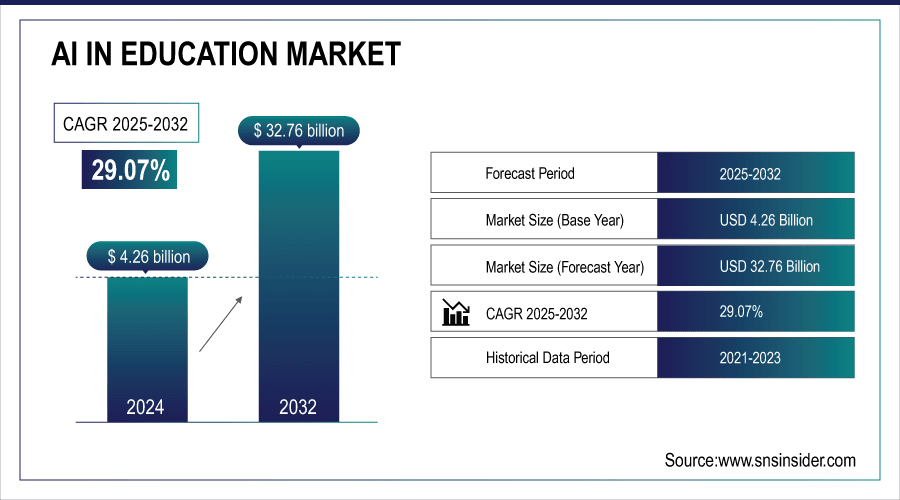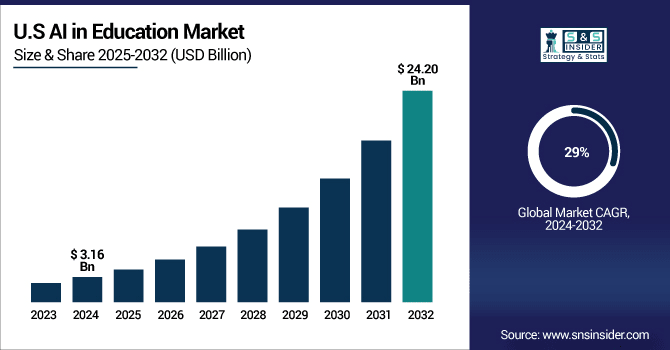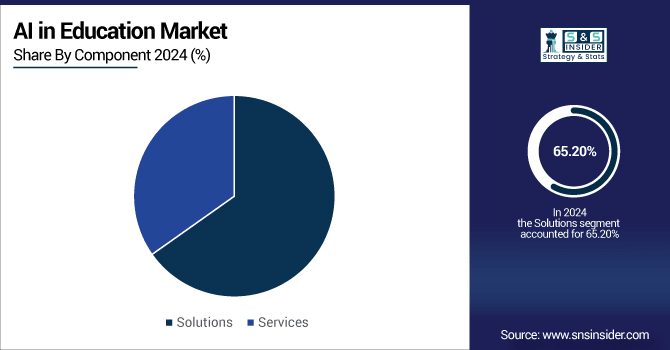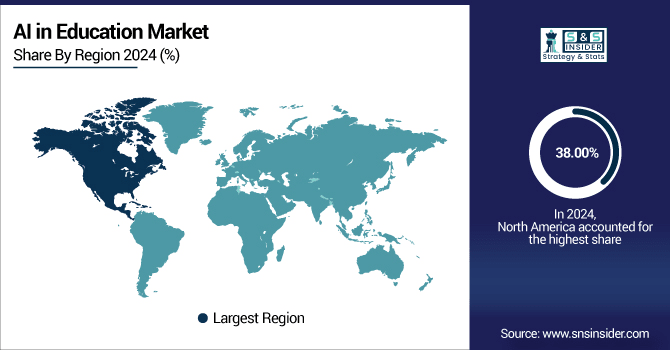AI in Education Market Analysis & Overview:
The AI in Education Market size was valued at USD 4.26 billion in 2024 and is expected to reach USD 32.76 billion by 2032 and grow at a CAGR of 29.07% over the forecast period of 2025-2032.

To Get More Information On AI in Education Market - Request Free Sample Report
The global market report covers the dynamics of global market, including the AI in Education market trends, technological advancements, competitive landscape, key players, regional and segment performance. The rapid implementation of artificial intelligence (AI) based learning solutions, the virtual facilitator and intelligent content & personalized educational systems is transforming the teaching and learning globally, helping in better efficiency & accessibility combined with engagement. Adaptive learning, predictive analytics, and AI-driven classrooms work in synergy to integrate AI across the education systems globally starting from schools to higher education to corporate learning segment.
For instance, over 45% of higher education institutions globally have integrated AI-based tutoring or assessment tools.
The U.S. AI in Education Market size was USD 3.16 billion in 2024 and is expected to reach USD 24.20 billion by 2032, growing at a CAGR of 29% over the forecast period of 2025–2032.

U.S. Market Growth is attributed to adoption of digitalization in classrooms, rampantly increasing incorporation of AI-enabled learning platforms, initiatives by the government to promote smart education and rising need to personalized learning experience. With high penetration of edtech solutions in the country, along with advanced IT infrastructure and significant investment in AI-enabled training programs, it further accelerates expansion. AI tools are improving K-12 schools, colleges and corporate training practices nationwide, resulting in better learning outcomes and greater efficiency.
For instance, over 60% of U.S. schools have integrated AI-powered learning platforms into their curriculum.
AI in Education Market Dynamics:
Key Drivers:
-
Widespread Integration of AI Tools Enhances Personalized Learning Experiences Across Schools and Universities
AI Education provides personalized learning, real time performance tracking, adaptive content and tailored feedback. With AI, educators can better detect gaps, enhance engagement, and ensure all students are learning optimally by analyzing individual learning behaviors. This is a way to improve the academic performance of the students, a way to reduce the dropping out of students and a way to increase the student satisfaction. Squirrel AI, for instance, uses machine learning to provide adaptive tutoring that enhances comprehension and retention. Wider use of AI-powered assessment tools along with analytics guarantees linear progression of learning solutions in methodologies, making tailored education affordable and scalable through K-12 schools, higher education and International online learning platforms globally.
For instance, AI platforms now deliver personalized learning paths to over 70% of students using adaptive tutoring systems.
Restraints:
-
Concerns Over Data Privacy and Security Restrict Large-Scale AI Implementation in Education Systems
AI systems require a considerable amount of data, which includes personal, academic, and behavioral data about students, that needs to be collected, processed, and stored. This leads to fears of data privacy, malpractice, and violations of GDPR, COPPA, etc. Concerns about cyber-attacks, abuse of sensitive data and the fact that there are no uniform security measures limits its expansion. We need to remember that institutions will be forced to invest more in cybersecurity, encryption, and access control, all of which will only increase both costs and complexity. Such privacy challenges may impede both K-12 and higher education use of AI, delaying the pace of technology adoption while straddling a fine balance between the promise of convenient technological support tools and regulatory, ethical accountability.
Opportunities:
-
Expansion of Cloud-Based AI Platforms Presents Opportunities to Democratize Education Globally
Different institutions across the globe are now utilizing cloud-based, scalable-based, digitally-accessible & budget-friendly AI solutions for learning. AI-driven platforms can be used by schools and universities with low investments–no need for heavy upfront infrastructure investment heavy-lifting. They power remote learning and virtual classrooms while facilitating remote assessments and adaptive assessment designs to ensure quality education delivery over a geography. Businesses such as Microsoft and Google are building up AI-powered cloud tools that will facilitate customizable learning and collaboration. The adoption of cloud computing, fast internet access, and mobile devices are increasing outside the traditional markets for high-end AI computing, allowing the possibility of integrating AI into under-served areas, closing the education gap, and enabling faster digital transformation in the developed and emerging digital markets.
For instance, over 55% of universities and K-12 schools globally now employ cloud-based AI learning platforms.
Challenges:
-
Integration Challenges with Legacy Systems Hamper Smooth Deployment of AI in Educational Institutions
A lot of schools and universities employ legacy IT systems that are not compatible with modern Artificial Intelligence solutions, making seamless integration a tough affair. Migrating the process to AI-driven platforms can be time-intensive, as the existing data needs to be standardized, made interoperable, and the staff given training as it necessitates a change in the way people work. Adoption is also slowed by technical challenges, resistance to change, and lack of IT expertise. Errors, inefficiencies, and operational disruption can occur when technical incompatibilities arise. This makes it expensive and complicated as providers need to customize AI solutions for each institution. Eliminating these integration obstacles is critical so that AI solutions can provide the greatest educational benefit and be embedded flexibly and sustainably across K-12, higher education, and corporate learning environments.
AI in Education Market Segmentation Analysis:
By Component
In 2024, Solutions segment accounted to 65.20% of the AI in Education Market share. The reason behind this entire one-stop solution for learning is the comprehensive learning platforms that provide adaptive content, analytics tools, and automated assessments. Focusing upon personalized learning, performance, and engagement, solutions dominate school, university, and corporate institutions. Squirrel AI offers integrated platform content, reporting, with real-time feedback, the most popular and revenue-generating pieces of solutions globally.
The services segment is anticipated to register the highest CAGR of 29.22% during 2025–2032. This growth is driven by growing demand for AI consulting, integration, training and maintenance support. They depend on professional services to efficiently deploy the AI platforms and then fine-tune them for the best performance. Through its training, technical assistance, and custom solutions, Pearson helps you embrace AI. The services segment is rapidly expanding due to the increasing adoption of AI-powered tools among schools, higher education and corporate learning.

By Application
The Learning Platform & Virtual Facilitators segment led the market in 2024 and garnered a 44.23% share of revenue. They provide facilities for interactive, adaptive, personalized learning experiences, ensuring effective engagement and analyzing student performance. Squirrel AI virtual instructors optimize learning outcomes and accessibility. Real-time monitoring of learning and providing feedback strengthen the integration of the solution with curricula and promote adoption, rendering this particular segment the largest K-12, higher education, and corporate segment and account for high revenue generation in the market.
Smart Content segment is predicted to grow at the highest CAGR of 31.26% during the forecast period of 2025-2032. Demand for AI-powered content creation, smart learning materials, and personalized resources are on the rise. McGraw Hill provides interactive textbooks, assessments and modules. Smart Content is the fastest-growing application globally, and as the digitalization of classrooms and corporate environments increases, technology adoption rapidly grows.
By Technology
In 2024, the Machine Learning segment accounted for the largest revenue share at 59.80%. Through the analysis, machine learning facilitates adaptive, predictive analytics, and performance tracking as it customizes students learning paths and boosts curriculum delivery to visual learning experience. Some platforms such as IBM Watson use machine learning that help for smart tutoring and recommendation. Largely due to its scalability, versatility and to existing proof of effective outcomes, it is the preferred technology in educational institutions and corporate training centres globally.
The Natural Language Processing segment is anticipated to be the fastest growing with a CAGR of 28.81% during 2025–2032. AI chatbots, virtual assistants, and automated grading systems are all powered by NLP to promote real-time interaction and to facilitate better engagement. NLP is used for language learning and feedback automation using platforms such as Duolingo. Global adoption rises rapidly due to widespread implementation of personalized learning, assessment, and knowledge management applications that leverage NLP becoming the fastest-growing AI technology in education.
By End-User
K-12 Education segment dominated the AI in Education Market with a 40.60% revenue share in 2024. Integrated tools for personalized learning, virtual classrooms, and AI assessments promote education efficiency and involvement, monitor students’ progress, and track learning outcomes. At the same time, early adoption strategies are being improved by schools using Squirrel AI to encourage long-term familiarity. In general, K-12 is the major revenue-generating and technology-integration segment of the global AI in Education Market.
Corporate Training & Learning segment is expected to expand at the fastest CAGR of 29.50% during 2025 to 2032. AI tools incorporate personalized training, modification tests, and performance feedback systems. For example, Coursera for Business products offer low-cost and scalable workshops for workers. At the same time, rapid expansion of demand for new skills, debriefs, and consistent career development promotes rapid growth in the segment’s involvement.
AI in Education Market Regional Analysis:
In 2024, North America led the AI in Education Market, holding a revenue share of 38.00%. This dominance is fueled by extensive adoption of advanced educational technology solutions, a well-established IT infrastructure, and strong investments in AI-driven learning platforms. Government programs aimed at digital learning, AI-based classroom tools, and commercial training solutions are the primary driver of the digital education market globally, with the U.S. holding the highest market share in the region. Major players such as IBM Watson and Squirrel AI are sustaining their market footprints to make sure that AI is used in all the schools and corporate learning environment globally.

Get Customized Report as per Your Business Requirement - Enquiry Now
-
The U.S. dominates North America due to advanced IT infrastructure, high digital adoption in classrooms, strong edtech investment, government initiatives supporting smart education, and widespread AI-based learning platforms. Leading companies including IBM Watson drive innovation and large-scale implementation across education.
Asia Pacific is expected to witness the fastest growth with a CAGR of 31.33% during 2025–2032. The growth is primarily driven by rapid digitalization, support from government towards smart digital education and rising investment in the edtech space. With the help of AI powered learning platforms, virtual classrooms, and smart content, countries such as China, India, and Japan are revamping education quality. Spurred by high penetration of smartphones, better internet access, and massive number of students, Asia Pacific is emerging as the fastest growing regional market for AI in education globally.
-
China dominates Asia Pacific owing to massive student populations, rapid digitalization, supportive government policies, and significant investments in AI-powered education platforms. Companies such as TAL Education enable personalized learning, virtual classrooms, and smart content, fueling rapid adoption and accelerating regional AI in Education market growth.
Europe’s AI in Education Market is driven by strong government support for digital education, increasing adoption of edtech solutions, and growing investment in AI-powered learning platforms. Countries including UK, Germany, and France implement personalized learning, virtual classrooms, and smart content. Leading providers, including Blackboard, are enhancing educational efficiency, engagement, and accessibility across schools, higher education, and corporate training sectors.
-
The United Kingdom dominates Europe’s AI in Education Market due to advanced digital infrastructure, high adoption of edtech solutions, strong government initiatives, and active presence of leading AI education providers, driving widespread integration across schools, universities, and corporate training sectors.
The UAE dominates the Middle East & Africa AI in Education Market due to government support, advanced IT infrastructure, and high adoption of AI-based learning platforms. In Latin America, Brazil leads with the largest student population, growing edtech adoption, and initiatives promoting digital and AI-powered education across schools, universities, and corporate training.
Key Players:
Major Key Players in AI in Education Companies are Google, Microsoft, Duolingo, BYJU’S, Pearson, Khan Academy, Coursera, Squirrel AI, Carnegie Learning, Cognii, Nuance Communications, Blippar, Century Tech, Querium, HowNow, KidSense, Practically, Docebo, MagicSchool AI and IONI and others.
Recent Developments:
-
In August 2024, Khan Academy's AI-powered teaching assistant, Khanmigo, continues to provide personalized tutoring and support to students across various subjects and grade levels.
-
In January 2024, Squirrel AI launched its flagship technology, the Large Adaptive Model (LAM), transforming personalized learning by integrating adaptive intelligence and multimodal agents.
| Report Attributes | Details |
|---|---|
| Market Size in 2024 | USD 4.26 Billion |
| Market Size by 2032 | USD 32.76 Billion |
| CAGR | CAGR of 29.07% From 2025 to 2032 |
| Base Year | 2024 |
| Forecast Period | 2025-2032 |
| Historical Data | 2021-2023 |
| Report Scope & Coverage | Market Size, Segments Analysis, Competitive Landscape, Regional Analysis, DROC & SWOT Analysis, Forecast Outlook |
| Key Segments | • By Component (Solutions and Services) • By Application (Learning Platform & Virtual Facilitators, Intelligent Tutoring System , Smart Content, Fraud & Risk Management and Others) • By Technology (Natural Language Processing and Machine Learning) • By End-User (K-12 Education, Higher Education and Corporate Training & Learning) |
| Regional Analysis/Coverage | North America (US, Canada, Mexico), Europe (Germany, France, UK, Italy, Spain, Poland, Turkey, Rest of Europe), Asia Pacific (China, India, Japan, South Korea, Singapore, Australia,Taiwan, Rest of Asia Pacific), Middle East & Africa (UAE, Saudi Arabia, Qatar, South Africa, Rest of Middle East & Africa), Latin America (Brazil, Argentina, Rest of Latin America) |
| Company Profiles | Google, Microsoft, Duolingo, BYJU’S, Pearson, Khan Academy, Coursera, Squirrel AI, Carnegie Learning, Cognii, Nuance Communications, Blippar, Century Tech, Querium, HowNow, KidSense, Practically, Docebo, MagicSchool AI and IONI |

